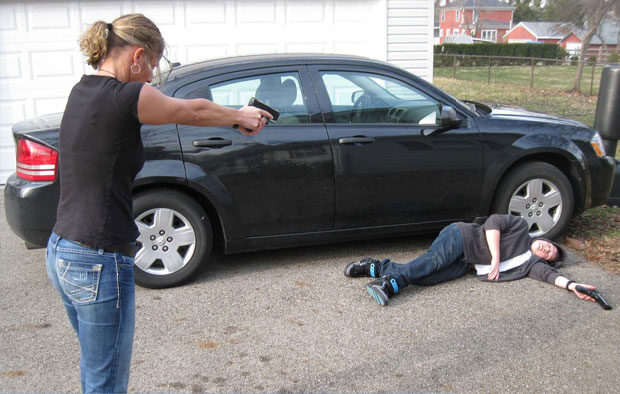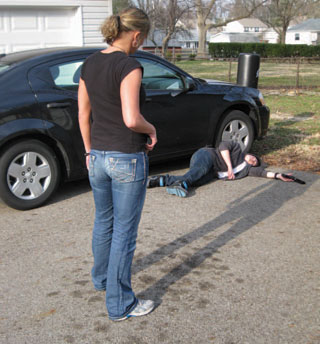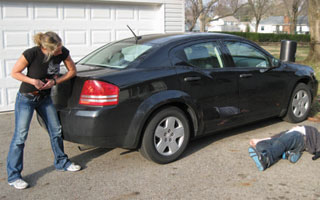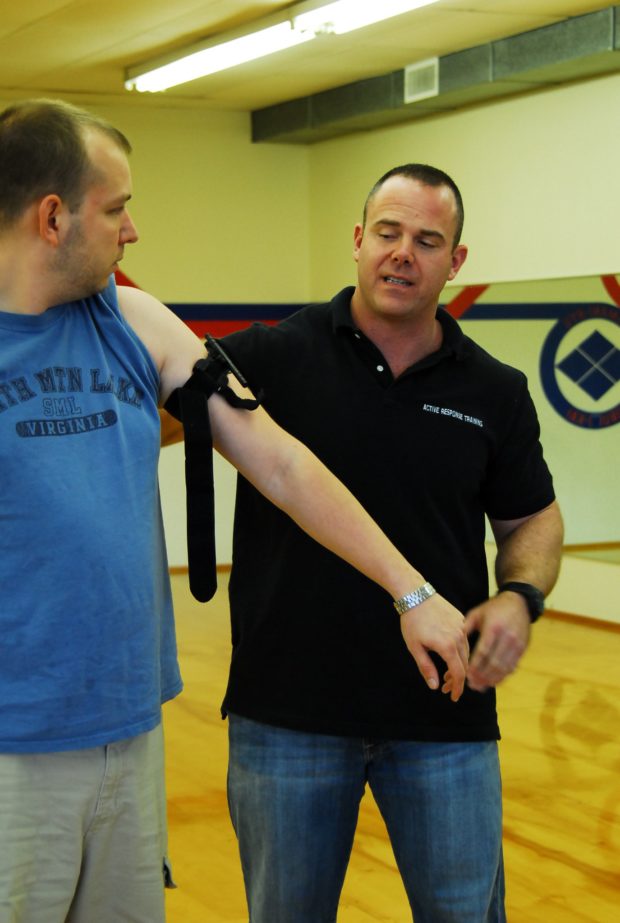Written by: Greg Ellifritz
While it the frequency of active killer attacks appears to be increasing, attacks like this aren’t a new phenomenon. The readers might remember Charles Whitman and the Texas Tower incident in the 1960s. People have been killing other people in public places for a very long time.
Most people don’t consider how alone they really are if they get caught in the midst of one of these shootings. Statistically, most are over in less than four minutes. Unless there is already a cop at the scene, there won’t be time for one to arrive. Police response has been, with a couple of exceptions, relatively inconsequential in past active shooter incidents. They arrive in time to clean up the mess.
Of the incidents that were stopped by people at the scene (as opposed to incidents where the shooter was not resisted in any way) 2/3 of the shooters were stopped by citizens, not cops. And in half of those cases the citizens were unarmed! Just like what happened in Arizona, a few citizens with incredible courage jumped on the shooter and stopped his rampage.
If you find yourself at the scene of an active shooter event, there are lots of things to consider. While this list isn’t comprehensive, it does provide some food for thought.
Do I engage or not? This is the big decision. Just because you are carrying a gun doesn’t mean you have a duty to protect everyone. It will almost always be safer for you to escape without shooting. If you engage, many negative consequences can result. It’s a decision you have to make in advance and it isn’t an easy one. Do I get out safely or do I risk my life to save others? Tough call.
Firearms- This is truly a “come as you are” event. I know many of people who carry long guns and a bunch of ammo in their cars to handle an active shooter. I hate to break it to you, but it isn’t likely to happen. Look again at the time frames involved. These events are over quickly. You just won’t have time to get the zombie- killing AR-15 out of your trunk.
That means you have to solve the problem with whatever you have on your person. How many of you carry a little .380 or .38 snub? Do you want to get into an active shooter gunfight with that weapon? Realize that shots may be long and there will be lots of innocent people running around the shooter in a panic. There may be more than one shooter. Can you make the shot with the little .380 you threw in your back pocket because you were just going to the grocery store? If you are going to be in this game you better have a real gun. That means at least having a mid-sized (think Glock 26- sized or bigger) all the time. Otherwise you are stacking the deck against yourself before you even start.
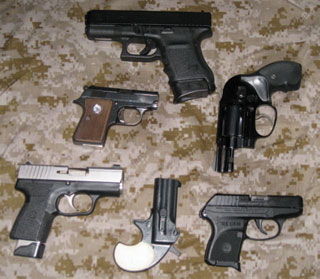
Any of these guns would do a fine job repelling a lone crackhead, but which would you rather have in an active shooter situation?
If you do get caught with a mouse gun, work on getting as close to the shooter as possible while keeping your gun hidden. Consider firing headshots. You need to put the guy down quickly and you probably don’t have a whole lot of rounds to spare.
At what distance can you guarantee a headshot with your carry gun? You need to know. Put yourself on a shot timer. Set it for two seconds. Start with the gun in hand, 10 feet from the target. Make the shot. If you make it in the two-second time frame, move back five feet. Keep doing that until you can’t reliably hit your target in two seconds. That’s your MAXIMAL engagement distance. Realize you will have to close to that distance in an active shooter event in order to make sure you don’t hit any innocent people. Most cops I train start missing shots around the 25 foot range. Do you still want to engage knowing you’ll have to run up within 25 feet of somebody who’s trying to kill everyone he sees?
Does this mean you should only shoot headshots? No, I’m not advocating that at all. I think headshots are a great choice when using a smaller caliber weapon that doesn’t hold much ammo. If I have a full- sized gun with 8-15 rounds, I may shoot center mass. It really depends on the circumstances. Either way, I use the same range standard. If you can make a two second headshot on the range, you can probably make a two second center mass shot at the same distance under the stress of someone shooting at you.
If you end up in a terrorist active shooter event with a small pistol, don’t forget about the idea of “battlefield pickup”. Shoot one terrorist and take his AK-47 (or whatever else he has) to shoot the rest of them. Any rifle is a whole lot better than a .38 snub. You may also be able to get better armament from a dead police officer if this is a longer engagement. Yes, these tactics can cause some problems, but I’d rather deal with some legal issues after the shooting than be killed because I couldn’t make a 50-yard shot with my .25 automatic.
If you are going to employ this strategy, you better know how to operate all the guns you could possibly encounter. Get some friends who own guns that you haven’t seen and have them show you how they work. That knowledge may save your life someday.
Tactics– This is a huge issue that really can’t be adequately addressed in the written format. Recognizing that, I will give you some of the more important things to consider and leave it up to you to figure out how to address them or to seek further training.
– How do I get to the shooter when everyone else is running away from him? It’s like swimming against the current. Do you have “people moving” skills that can get you through the crowd?
– How do I conceal my gun when working my way to the shooter? If you don’t conceal it, you may be mistaken for the shooter by a cop or another CCW permit holder. It’s difficult balancing the competing needs of staying low profile, yet ready at the same time. In the Arizona shooting, one of the men who responded was armed. When he heard the shots being fired, he unholstered his 9mm pistol, and put it in his pocket (with his hand still on it) as he made his way to confront the shooter. That was a very smart move. He had instant access to the gun, but no one else saw it.
– How can I make sure there isn’t more than one shooter and what do I do if there are multiple attackers? Some of these active shooters are terrorists. They may have “handlers” or protectors watching the crowd for armed people. Those handlers will remain low profile and they will wait until you pull your gun and focus on the shooter. When you do that, they’ll shoot you in the back of the head. How do you prevent that?
– Do you have the patience and knowledge to exploit opportunities to act? In many active shootings, the shooter is brought down when his gun malfunctions or he is in the act of reloading. It may be smart to immediately seek cover and wait to act until you see one of these opportunities. Do you know what a malfunctioned gun looks like? Can you recognize when a shooter is reloading?
– Get help! If you are in a physical confrontation with the shooter, try to get as many people as possible to help you. Often, in times of intense stress, bystanders freeze and don’t know what to do. Sometimes a little encouragement is all that is needed to spring them into action.
As two men tackled the 2011 active killer in Arizona, they noticed he was trying to access a magazine to reload even as they were fighting. The men yelled out to Patricia Maisch, a 61-year old woman who was laying on the ground nearby. They told her to take the magazine away from the shooter. Despite her advanced age and fear, she did just that. In that single action, she did as much to incapacitate the shooter as the brave men who wrestled him to the ground. Call out for help. You just might get it!
How do I avoid getting shot by the police? This is a very real danger. As you whip out your CCW gun and shoot the killer, a cop is arriving. He sees a whole bunch of bodies and you holding a gun. What would you do if you were in the cop’s shoes?
If you choose to act, get your gun out of sight as soon as the threat is neutralized. Holster it. Keep your hand on the gun if you think you need to, but don’t be in a high-profile shooting stance. Position “Sul” is useful here too if the threat is still active.
You may have to deal with the shooter’s gun as well. If you disarm the shooter, the same rules apply. Get the gun out of sight as soon as possible. Don’t throw it away; there may be other shooters in the crowd who can use it against you. Quickly make it safe and hide it. If you keep it out, people will assume that you are the shooter. For more information on this topic, see my article on Weapon Handling in the Active Killer Event.
Get to cover. Not only cover from the shooter you just dropped, but also cover between you and the police, Start looking for the responding cops. Be ready to drop your gun, show your hands and get down on the ground. Know what is coming and follow the cops’ orders quickly.
Yelling out that you are a CCW permit holder isn’t likely to keep you from being shot. People experience auditory exclusion under stress and simply don’t hear things well. Cops on the scene will be judging all of your actions while attempting to figure out who you are. The person trying to help victims isn’t as likely to be mistaken for the shooter. Yelling things like “Get down, he has a gun!” “Get away from him, he’s still armed!” and “Somebody call 911″ are better than screaming that you have a CCW permit.
If you have family or friends with you, have them call 911. Make sure they tell the police that you are the good guy and describe what you are wearing. If the police know there are other good guys with guns on the scene before they arrive, they will be looking for them. That may keep you from getting shot.
Medical skills- After the shooting is over, there will be lots of injured people who need help. Everyone should know how to treat battlefield injuries. Paramedics will not be allowed to enter the scene until the police are sure that there is no more danger. In a simple shooting, the gunshot victims may be on their own for upwards of 15 minutes before the first wave of EMS is allowed in. Some gunshot wounds can cause a person to bleed to death in less than four minutes. Do the math. If you or someone you care about is a victim, you’ll want to be able to provide some basic trauma care until the pros get there.
Battlefield trauma is different from the standard injuries most people see. Uncontrolled bleeding is the leading cause of preventable battlefield death. Worry about this first. Plug the holes! Grab whatever you can find, place it over the wound and squeeze hard. If there is spurting arterial bleeding, make a tourniquet and apply it as high up on the wounded limb as possible.
Battlefield first aid isn’t hard. If you can stop bleeding with improvised pressure dressings and tourniquets, patch a sucking chest wound, prevent a tension pneumothorax, and know how to position a casualty to keep his airway clear, you will save lives. There are training classes available. What I described above can be learned in about four hours.
This article isn’t a comprehensive review on active shooter strategy. What I hope to do is to familiarize some of you with the issues and get you to think about your response. Get some training and stay safe!

